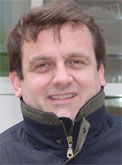Curriculum vitae
 Dr. George Christakos is a Distinguished Professor of Geography at the San Diego State University (California) and a Professor at the School of Public Health of the University of North Carolina-Chapel Hill. He has worked on several major interdisciplinary projects in USA, Spain, Italy, England, Belgium, Greece, Russia, Bangladesh, and Egypt. His teaching and research activities focus on the advanced modelling and space-time mapping of interdisciplinary natural systems, including: Multi-sourced knowledge synthesis and data assimilation; Random field models and spatiotemporal statistics; Human exposure analysis and health effects; Integrated temporal GIS, medical geography and spatiotemporal epidemiology; Model-based risk assessment, decision making and planning. Dr. Christakos is the author/co-author of six books and over hundred papers on different scientific subjects.
Dr. George Christakos is a Distinguished Professor of Geography at the San Diego State University (California) and a Professor at the School of Public Health of the University of North Carolina-Chapel Hill. He has worked on several major interdisciplinary projects in USA, Spain, Italy, England, Belgium, Greece, Russia, Bangladesh, and Egypt. His teaching and research activities focus on the advanced modelling and space-time mapping of interdisciplinary natural systems, including: Multi-sourced knowledge synthesis and data assimilation; Random field models and spatiotemporal statistics; Human exposure analysis and health effects; Integrated temporal GIS, medical geography and spatiotemporal epidemiology; Model-based risk assessment, decision making and planning. Dr. Christakos is the author/co-author of six books and over hundred papers on different scientific subjects.
TOP ^
Publications
His most recent books are:
- Christakos, G., P. Bogaert, & M.L. Serre, Temporal GIS. Springer-Verlag, New York, N.Y, 2002.
- Christakos, G., R.A. Olea, M.L. Serre, H.L. Yu, and L-L. Wang: Interdisciplinary Public Health Reasoning and Epidemic Modelling: The Case of Black Death. Springer, New York, N.Y., 2005.
TOP ^
Conference
Developments in Interdisciplinary Spatiotemporal Modelling
This seminar will present modern concepts and methods of integrated modelling in interdisciplinary space-time environments. It has been said that to be is to be connected. In this sense, the development of an integrated space-time approach should reside on organized connectedness between the various scientific disciplines uner conditions of multi-sourced uncertainty. A knowledge synthesis framework can provide the rational means for assimilating a variety of information bases (general and site-specific) that are relevant to the natural system of interest. Epistemic cognition techniques can produce a realistic representation of the system, provide a rigorous assessment of the uncertainty sources, and generate informative predictions across space-time. The mathematics of integrated modelling involve a powerful and versatile spatiotemporal random field theory and stochastic logic principles that impose no restriction on the shape of the probability distributions or the form of the predictors, and accounts rigorously for the uncertainty features of the natural system. Analytical examples will be discussed and real-world case studies will be examined.
 Dr. George Christakos is a Distinguished Professor of Geography at the San Diego State University (California) and a Professor at the School of Public Health of the University of North Carolina-Chapel Hill. He has worked on several major interdisciplinary projects in USA, Spain, Italy, England, Belgium, Greece, Russia, Bangladesh, and Egypt. His teaching and research activities focus on the advanced modelling and space-time mapping of interdisciplinary natural systems, including: Multi-sourced knowledge synthesis and data assimilation; Random field models and spatiotemporal statistics; Human exposure analysis and health effects; Integrated temporal GIS, medical geography and spatiotemporal epidemiology; Model-based risk assessment, decision making and planning. Dr. Christakos is the author/co-author of six books and over hundred papers on different scientific subjects.
Dr. George Christakos is a Distinguished Professor of Geography at the San Diego State University (California) and a Professor at the School of Public Health of the University of North Carolina-Chapel Hill. He has worked on several major interdisciplinary projects in USA, Spain, Italy, England, Belgium, Greece, Russia, Bangladesh, and Egypt. His teaching and research activities focus on the advanced modelling and space-time mapping of interdisciplinary natural systems, including: Multi-sourced knowledge synthesis and data assimilation; Random field models and spatiotemporal statistics; Human exposure analysis and health effects; Integrated temporal GIS, medical geography and spatiotemporal epidemiology; Model-based risk assessment, decision making and planning. Dr. Christakos is the author/co-author of six books and over hundred papers on different scientific subjects.